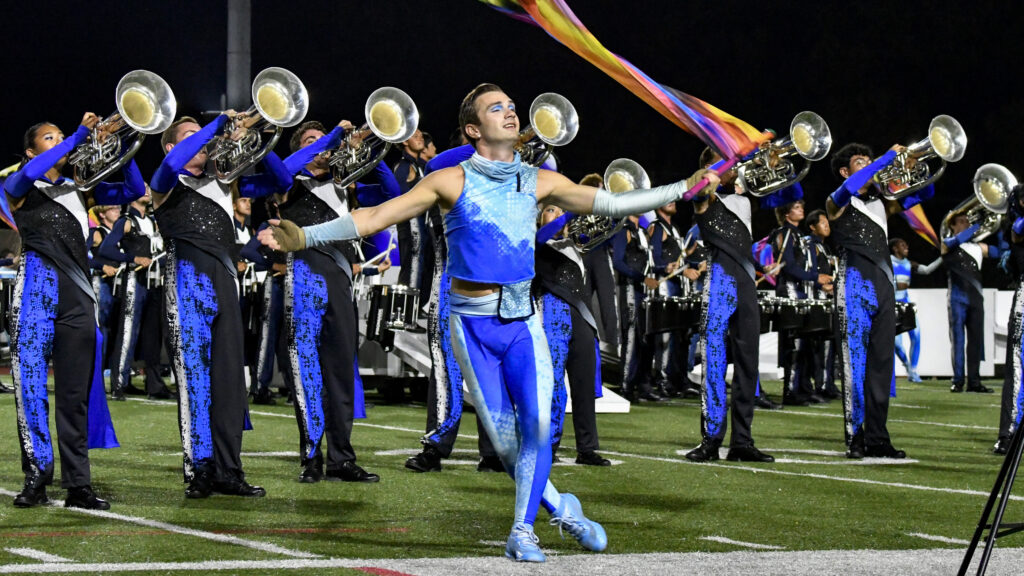The 2015 Drum Corps International World Championships witnessed the Blue Devils win their 17th World Championship title with “Ink,” after finishing fourth in Prelims due to a half a point warm-up penalty that placed the corps under Carolina Crown, Bluecoats, and The Cadets.
The big news in Semifinals was Crossmen eking its way into the Finals competition by less than a tenth of a point over Troopers, after receiving 1.4 points in overtime penalties due to a late start caused by a balking amplification system.
The Boston Crusaders celebrated the corps’ 75th anniversary and Cavaliers finished in ninth place, the corps’ lowest placement in 32 years.

The Cadets finished in fourth with “The Power of 10,” which often featured the Roman numeral X in drill formations. Color guard members wore bright neon costumes as a nod to the periodic table of elements where neon has an atomic number of 10.
Other visuals to set the theme included small tarps laid out by the corps which turned every yard line at Lucas Oil Stadium in Indianapolis into a 10-yard line, both in the front and back of the field. And for added measure, the corps utilized 10 snare drums and 10 tuba players in its ranks.
Many fans were shocked when the corps, mid-season, switched its traditional maroon West Point jackets for all-black uniforms. The horn lines in the three corps that placed above The Cadets in the Finals competitions may have been equally as surprised when the Allentown corps’ horn line scored high enough to win the Jim Ott Best Brass Performance Award.
The music for “The Power of 10” was mostly based on “Symphony No. 10 in E minor” by Russian composer Dmitri Shostakovich.
The show’s opener started with the brooding “Moderato” movement of the symphony. It’s been suggested that this mournful piece was the composer’s commentary on how depressing life was under the oppressive reign of Stalin.
On the football field, The Cadets accompanied the music with a narrator slowly counting from 1 to 10, each recitation of a number accompanied by an equal number of color guard members tossing or twirling their equipment. The horns formed a giant curved “X” just at the point when 10 rifles were tossed up front.

The second segment of the opener was the symphony’s second movement, “Allegro,” a fast-paced, violent tableau that some musicologists believe was Shostakovich’s musical portrait of Stalin’s anger and tyranny. The corps maintained a tempo of 186 beats-per-minute for four grueling minutes, ending the movement with two “X” drill formations in the brass that, via a transitional asterisk, turned into one giant “X.”
The show’s second production was “Diane and Camilla,” a lyrically haunting ballad by Angelo Badalamenti written for David Lynch’s 2001 psychological thriller murder mystery, “Mulholland Drive.”
Ten podiums that had been scattered around the field from the start of the show were re-arranged down the 45-yard lines. The podiums then became a platform from which to feature individual color guard members and numerous brass players. Pastel flags individually marked with numbers 1 through 10 popped up whenever each flag’s respective number was recited in the narration. The movement ended with the brass players marching forward in a block between the numbered flags.
The third production was the waltz-like nocturne third movement from the symphony, “Allegretto.” The introductory slow segment featured six front ensemble players playing six different tambourines while color guard members tossed hoops representing the “0” digit in the number 10.
During the next segment of the movement, tempos hit a blistering 236 beats-per-minute prior to the climactic moment when 10 symphonic French horn players climbed atop the podiums to play a plaintive-but-dramatic harmonized feature inspired by the solo French horn motif near the end of the movement. The rest of the horns countered the increased harmonies of the French horns with frenetic outbursts.
The final segment of the show was from the symphony’s fourth and last movement, “Andante – Allegro,” which mixes gloom and playfulness. The main theme of this movement was introduced by the tubas and then passed around various brass sections, leading into a standstill statement by the full-corps.
The pace of the show was unrelenting, leading into several quick drill evolutions of spinning and mutating “X” forms, ending with the corps forming the word, “TEN,” just prior to unveiling a tribute to the corps’ legendary “Z-pull” maneuver, which brought the show to an optimistic ending of uninhibited joy.

Michael Boo was a member of the Cavaliers from 1975-1977. He has written about the drum corps activity for more than 35 years and serves as a staff writer for various Drum Corps International projects. Boo has written for numerous other publications and has published an honors-winning book on the history of figure skating. As an accomplished composer, Boo holds a bachelor's degree in music education and a master's degree in music theory and composition. He resides in Chesterton, Indiana.





